Musk oxen have undergone various adaptations that help them survive the harmful conditions of the Arctic Tundra. These include double-layered insulation, a large body size, strong hooves, a unique stomach, and various defensive changes.
Musk Oxen weren’t always the same. With time, they started to evolve and undergo various adaptations that helped them better survive the harsh environment of the Arctic Tundra.
Want to learn more about these unusual adaptations? Then gear up and dig through the article!
Has Musk Ox Undergone Any Change Over the Years To Adapt To The Tundra?
Yes!
Musk Oxen have undergone various behavioral, physiological, and anatomical adaptations to better adapt to the harsh environment (-40°C and sometimes even less) of Artic Tundra.
These adaptations helped them not only in thermoregulation but also in food conservation and sexual dimorphism.
A Few Known Adaptations
Where a Musk Ox went under numerous changes, enlisting all of them is not possible.
So, here are some of the major adaptations that helped Musk Ox put up with the harsh environmental conditions:
Double-layered long hair coat
One of the prime adaptations of the Musk ox is its double layered long hair coat.
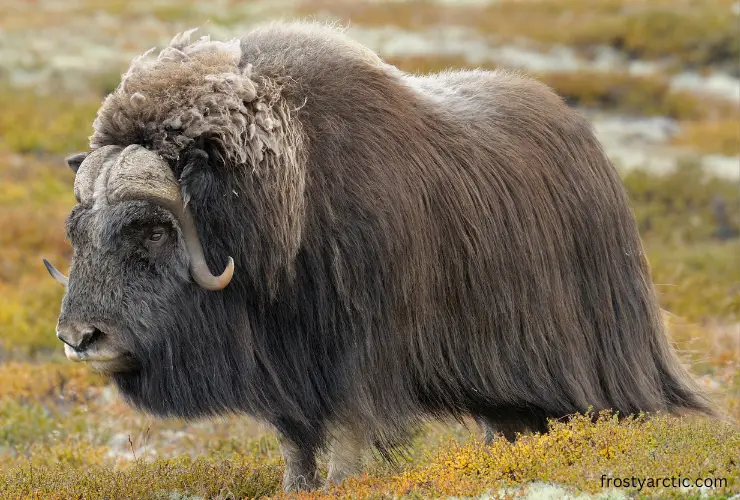
The outer layer comprises longer, comparatively coarse hairs, while the inner layer is soft and wool-like in texture.
These two layers help to:
- Shed moisture and snow
- Trap air, and thus play a role in thermoregulation
- Retain body heat
Furthermore, the speckled outer coat serves as an excellent camouflage for Musk Oxen, allowing them to blend in with the ice and thus avoid predators’ gaze.
Hooves
Yet another adaptation is their large, broad hooves. These large surface area claws aid in weight distribution, allowing the Musk Ox to gain better traction and control while walking on snow.
Moreover, these hooves are strong and durable, which helps the Musk Ox dig through the snow and find food.
Preserve body fat
Furthermore, Musk oxen store body fat as an adaptation to the harsh conditions of the Arctic tundra—the stored fat serves as a food source during the winter when food is scarce.
Musk ox typically eats more, stores extra fat in the summer when food is plentiful and uses it in the winter when food is scarce.
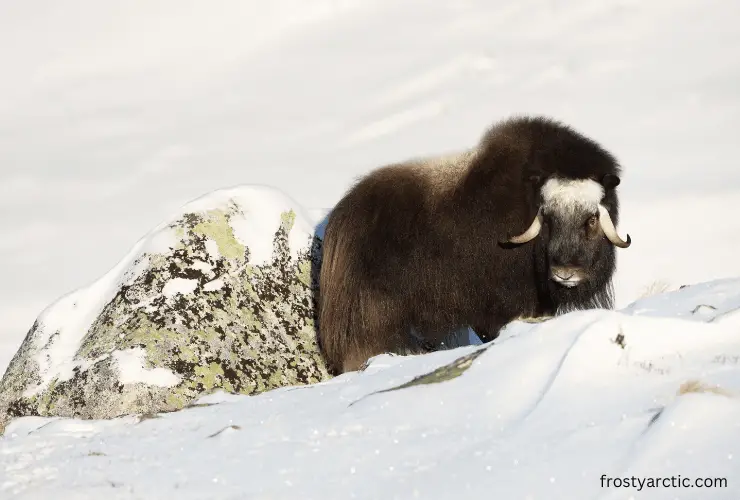
The thick coat helps preserve fat by reducing extra energy expenditure. Moreover, they slow down their metabolism to conserve energy.
Horizontal Slit Eyes
The Musk Ox and most Arctic animals, including Arctic wolves and foxes, have horizontal slit eyes.
They have horizontally elongated pupils instead of round ones like humans. These elongated pupils help:
- Reduce the glare of the sunlight that reflects off from the snow and ice
- Provide a wider view to detect predators
- Increase depth perception that allows these animals to move over the unbalanced terrains
Live in Herd
One of the behavioral adaptations of Musk ox is that they prefer to live in groups called herds.
In this way, they can use their strength together and deter the predators, thus making them less vulnerable to predators.
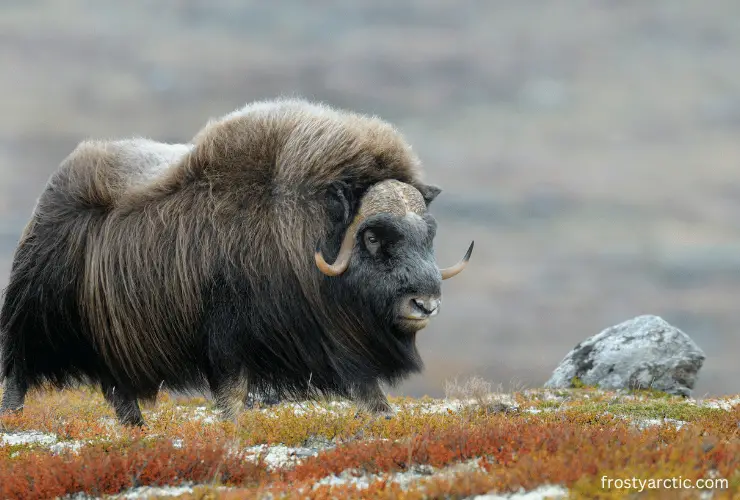
Moreover, the herd helps them to huddle together and indirectly contributes to thermoregulation.
Four chambered stomachs
It is yet another successful anatomical adaptation of the Musk ox.
They have a four-chambered stomach that helps them extract maximum nutrients from the food by regurgitating and rechewing.
Moreover, digestion produces fatty acids, which Musk Ox takes up as an energy source.
Defensive Adaptations
The Musk Ox has also undergone a number of defensive adaptations that aid in survival and escape from predators.
This includes their excellent sensing abilities, especially hearing and smelling.
Their ears swivel easily in different directions and thus help them hear frequencies and locate predators.
Similarly, they use their exceptionally strong sense of smell to detect food from long distances.
Moreover, they form a Musk Ox Ball circle, with their calves inside the circle and sharp horns facing toward the enemy.
This strategy deters the predator and prevents him from attacking any of its members.
Reduce metabolic rate
Musk Ox are known to reduce their metabolic rate by reducing their heart rate and muscle activity. This helps them maintain their body temperature and conserve body.
Do Musk Oxen Share Any Adaptations Similar to Polar Bears?
Although polar bears are carnivorous and Musk Ox are herbivorous, they do share some characteristics. These include:
- A deep layer of insulation in the form of fur and fat helps thrive in the cold conditions of the Arctic Tundra. Polar bears have blubber, while Musk Oxen have shaggy fur coats.
- Large body size to conserve heat and fend off predators
Which Adaptations of The Musk Ox Are Similar To That Of The Caribou?
Musk Ox and Caribou have several adaptations in common, including:
- Both prefer to move slowly, not to roam about, and not to go under long migrations. This helps the two animals to keep their energy output low and thus conserve a lot of energy which they use later on to survive in food scarcity conditions.
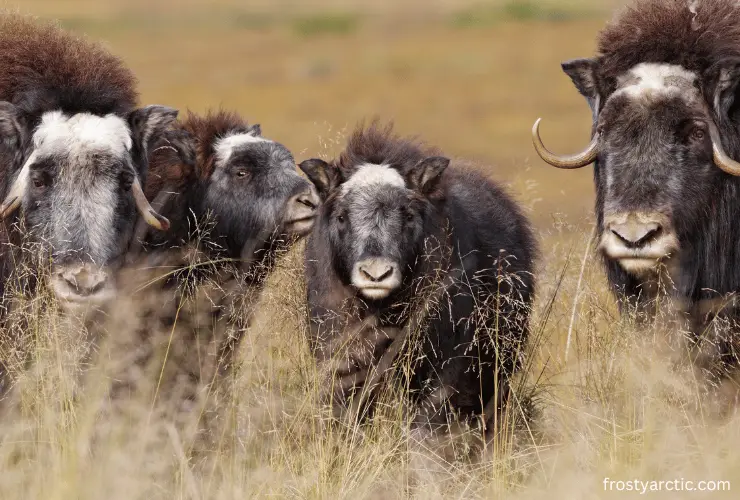
- Both have long, broad hooves that help them move on water and snow and maintain stability.
- Musk Oxen and Caribou both have a thick layer of fur coat that aids in thermoregulation.
Frequently Asked Questions (FAQs)
How does Musk Ox protect themselves?
Musk Ox has undergone various physiological and behavioral adaptations to protect itself from predators.
For example, they prefer to live and move in groups called herds.
Moreover, they form a circle called Musk Ox Ball to deter predators.
They also have long horns that help attack and keep the predators at bay.
Why is Musk Ox fur so special?
Musk Ox fur is made of two layers; the outer one of guard hairs and the inner one of short hairs that act as an insulating coat.
The fur of the Musk ox is counted among the finest wools worldwide.
A rough comparison states that it is eight times warmer and insulating than sheep fur.
Does Musk Ox release a smell?
Yes!
Musk Ox emits a very strong, pungent smell during the summer mating season. That is why they are called Musk Oxen. (MUSK is a strong-smelling substance).
Conclusion
All in all, Musk Oxen have undergone various adaptations that help them thrive better in the harsh environment of the Arctic Tundra.
These include the conservation of energy, reduction of metabolic rate, fat preservation, sharp horns, broad hooves, etc.
All these behavioral, physiological, and anatomical adaptations combine to help Musk Ox live successfully in those harsh climatic conditions.

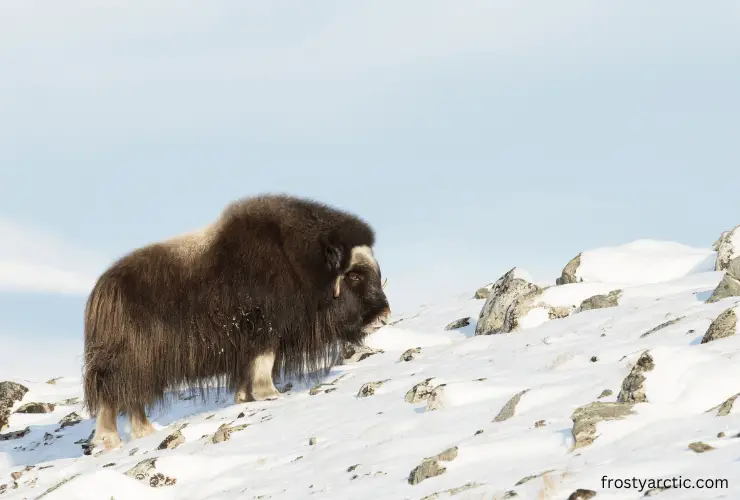

2 thoughts on “How Do Musk Oxen Adapt to The Tundra?”